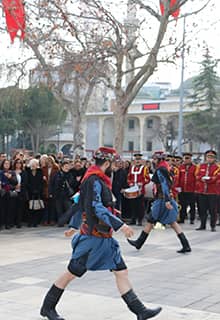

listen
Denizli
Denizli Rooster
The symbol of Denizli, Denizli Rooster, a natural race unique to the region, has a privileged place with its harmonious color and voice that can crow for 20-30 seconds. Besides its long and beautiful crow, it also attracts attention with its fabulous beauty and noble stance. According to the tone of the Denizli Rooster voice, it is divided into thin, bass and deep voice. Denizli Rooster, which has the title of the longest crowing rooster in the world, can sing with sad, screeching, wavy (sarcastic) sounds that resemble different melodies. Denizli Rooster is a symbol and the mythological legend of the city, engraved on stones from the ancient world. According to the legend, the sentry who does not fulfill the duty given by Ares is turned into a rooster and punished. There is a rooster motif in an inscription belonging to a medical student in the Hierapolis Ancient City (Hierapolis Antik Kenti) and a rooster figure from the 2nd century CE in the works found in Laodikeia Ancient City (Laodikya Antik Kenti).
Denizli Tavas Zeybek and Zeybek Music
The Zeybek Music, which represents the story of the “Efe’s” resistance and struggle against injustice, who has an important place in Anatolian culture and folk tales, appears as a common folklore element in Denizli and its regions. Zeybek musics which create a rich melodic structure with various instrumental and vocal sounds, are played with drum-zurna, drum-clarinet or Meydan Sazı and darbuka. Continuing to be kept alive in different regions of Denizli, Tavas Zeybek tells the heroic stories of the people with its unique melody, clothes and heavy figures. This cultural heritage, passed down through generations, has been included in the UNESCO Intangible Cultural Heritage List.
Pine Whistle-Sipsi Instrument
The making of “pine whistle - sipsi”, which is common in Acıpayam, Beyağaç, Çameli, Kale, Tavasdistricts and villages of Denizli, is a valuable cultural element. Sipsi is a handcrafted wind instrumentmade from reed or fresh pine branches, locally called kargı. The pine whistle, thought to have emerged as a result of the shepherd’s culture, not only symbolizes the original creativity of the local people, but also constitutes one of the riches of Turkish folk music. Hayri Dev, who was born in Denizli, has successfully carried this tradition from generation to generation and has transferred the making and performance of sipsi to new generations, was selected as the UNESCO Living Human Treasure in 2008.
Yörük Cura
The “three-stringed” cura instrument, which is widely performed in conversation meetings where local people living in Acıpayam and Çameli districts and rural areas come together in rural and houses, has a special sound. Yörük folk songs performed with yörük cura, which is one of the saz instruments, constitute unique examples of Turkish folk music.
Pamukkale Legend
It is a legendary story that tells of the daughter of a poor lumberjack family becoming beautiful with the sedimentary water when she throws herself off from the foothills of Çökelez Mountain (Çökelez Dağı). This legend, which has been told for many years, represents the centuries-old fame of Pamukkale’s healing waters and the beauty secrets of women.
It is a pleasure to listen to many interesting stories and mythological stories of Denizli’s Ancient periods.








